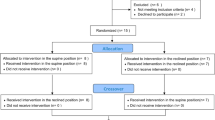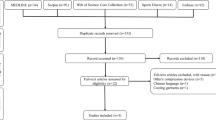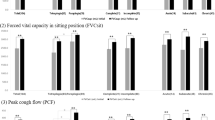Abstract
Study design:
Literature review.
Objectives:
The recognized effect of breathing on venous return and cardiac output has not been assessed in the spinal cord injury (SCI) patient. To test this effect indirectly, the breathing capacity and blood pressure have been compared at various levels of SCI.
Setting:
SCI service, Massachusetts, USA.
Methods:
Spinal cord-injured subjects with complete motor paralysis were studied. The forced vital capacity (FVC) (one study, 455 subjects, 91% male) was compared with the mean blood pressure (MBP) (one study, 461 subjects, 100% male) of subjects by level of paralysis.
Results:
For lumbar to cervical levels of paralysis, FVC and MBP each diminish progressively. To compare FVC directly with MBP by level of paralysis, r=0.85, P<0.001.
Conclusion:
Breathing capacity is correlated with blood pressure in SCI patients.
Similar content being viewed by others
Introduction
Venous return to the chest supports cardiac output and, in turn, blood pressure (BP) as a manifestation of cardiac output. Invasive flow measurements in animals and a CO2 rebreathing technique in able-bodied human subjects have demonstrated this relationship.1, 2 Breathing supports venous return. Tidal volume over a wide range in the able-bodied is directly correlated with cardiac output.2 It has recently been shown that forced vital capacity (FVC), a measure of breathing capacity, is closely related to the level of a spinal cord lesion – the higher the lesion, the lower the FVC.3, 4, 5, 6 Similarly, BP has been correlated with the level of paralysis – the higher the level the lower the BP.7 If breathing supports venous return and cardiac output, then FVC, a parameter of breathing capacity, might be correlated with BP, a bedside measure of cardiac output. The FVC and blood pressure from these reports have been compared.
Methods and results
The subjects in the studies compared are similar (see Table 1). Taking the published data, the FVC has been compared with mean blood pressure (MBP). FVC fell from 89% of predicted (by height, age, ethnic group, sex) at the lumbar levels to 61% predicted at cervical levels. MBP fell from 113 mmHg at the lumbar levels to 96 mmHg at cervical levels. The progressive decline toward higher levels of paralysis for both measurements is shown in Figure 1. When FVC and MBP are normalized to fractions of the lumbar values, the correlation between FVC and MBP through the range of levels of paralysis is high. By linear regression analysis,8 n=13, r=0.85, P<0.001.
Discussion
Since FVC and MBP have been related to levels of the spinal cord lesions, separately and in the same direction, the correlation between FVC and MBP was predictable. Nevertheless, the correlation coefficient for FVC to BP is quite high, despite the derivation of data from independent studies and the nonstandard position of the BP subjects. That being said, a causal relationship between FVC and BP can be claimed only if breathing at rest or tidal volume, which normally affects venous return through negative pleural pressure, is represented by FVC. A reduced FVC is, in fact, associated with a reduced tidal volume in severe spinal cord injury (SCI).9 There is reason to believe, therefore, that FVC represents tidal volume and its effect on venous return, cardiac output, and BP.
Two other factors that could affect venous return, cardiac output, and BP in SCI patients can be suggested. (A) Blood volume is reduced by SCI, factors identified being reduced red cell mass and increased vascular leakage of albumin.10, 11, 12, 13, 14 The role of the level of SCI in blood volume may parallel that of FVC and BP. (B) Increased venous capacitance could reduce venous return. In fact, however, venous capacitance is reduced.15 For ascending SCI lesions both breathing disability and intravascular volume might contribute to the observed BP reduction – and account for the reduced left ventricular mass seen in these patients.16, 17
Conclusion
Increasing severity of SCI is associated with decreasing breathing capacity and BP. These two deficits are indirectly related since breathing is a factor in venous return and cardiac output. Intravascular volume may be another factor in the reduced BP of more severe SCI. These factors together may affect response to illness such as sepsis, which carries a high mortality due to shock.18
References
Brecher G . Venous Return. Grune and Stratton: New York 1956.
Boutellier U, Farhi LE . Influence of breathing frequency and tidal volume on cardiac output. Respir Physiol 1986; 66: 123–133.
Almenoff PL, Spungen AM, Lesser M, Bauman WA . Pulmonary function survey in spinal cord injury: influences of smoking and level and completeness of injury. Lung 1995; 173: 297–306.
Linn WS, Adkins RH, Gong H, Waters RL . Pulmonary function in chronic spinal cord injury: a cross-sectional survey of 222 southern California adult outpatients. Arch Phys Med Rehab 2000; 81: 757–763.
Baydur A, Adkins RH, Milic-Emili J . Lung mechanics in individuals with spinal cord injury: effects of injury level and posture. J Appl Physiol 2001; 90: 405–411.
Linn WS, Spungen AM, Gong Jr H, Adkins RH, Bauman WA, Waters RL . Forced vital capacity in two large outpatient populations with chronic spinal cord injury. Spinal Cord 2001; 39: 263–268.
Frankel HL, Michaelis LS, Golding DR, Beral V . The blood pressure in paraplegia I. Paraplegia 1972; 10: 193–198.
Glantz SA . Primer of Biostatistics. 4th edn. McGraw-Hill: New York, NY 1997.
James III WS, Minh VD, Minteer MA, Moser KM . Cervical accessory respiratory muscle function in a patient with a high cervical cord lesion. Chest 1977; 71: 59–64.
Ring J, Seifert J, Lob G, Stephan W, Probst J, Brendel W . Elimination rate of human serum albumin in paraplegic patients. Paraplegia 1974; 12: 139–144.
Ranlov P, Rossing N, Schwartz M, Eskensen B, Rasmussen G . Late hypoalbuminaemia and albumin metabolism in paraplegic and tetraplegic patients. Clin Sci 1972; 43: 639–644.
Cardus D, McTaggart WG . Total body water and its distribution in men with spinal cord injury. Arch Phys Med Rehabil 1984; 65: 509–512.
Houtman S, Oeseburg B, Hopman MT . Blood volume and hemoglobin after spinal cord injury. Am J Phys Med Rehabil 2000; 79: 265–269.
Zhukova EM . Effect of partial transection of spinal cord on permeability of cutaneous vessels in rats before and after treatment with neurotoxic dose of capsaicin. Bull Exp Biol Med 2000; 129: 340–341.
Wecht JM, de Meersman RE, Weir JP, Bauman WA, Grimm DR . Effects of autonomic disruption and inactivity on venous vascular function. Am J Physiol Heart Circ Physiol 2000; 278: H515–H520.
Kessler KM et al. Cardiovascular findings in quadriplegic and paraplegic patients and in normal subjects. Am J Cardiol 1986; 58: 525–530.
Eysmann SB, Douglas PS, Katz SE, Sarkarati M, Wei JY . Left ventricular mass and diastolic filling patterns in quadriplegia and implications for effects of normal aging on the heart. Am J Cardiol 1995; 75: 201–203.
Wall BM, Mangold T, Huch KM, Corbett C, Cooke CR . Bacteremia in the chronic spinal cord injury population: risk factors for mortality. J Spinal Cord Med 2003; 26: 248–253.
Author information
Authors and Affiliations
Rights and permissions
About this article
Cite this article
Frisbie, J. Breathing and the support of blood pressure after spinal cord injury. Spinal Cord 43, 406–407 (2005). https://doi.org/10.1038/sj.sc.3101732
Published:
Issue Date:
DOI: https://doi.org/10.1038/sj.sc.3101732




